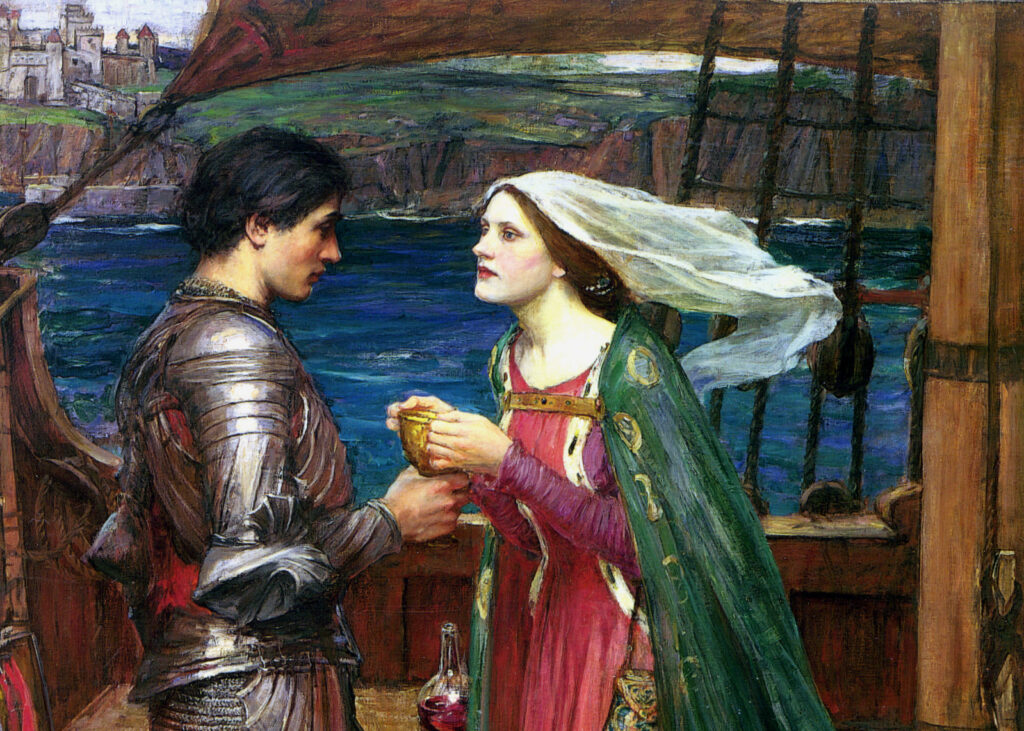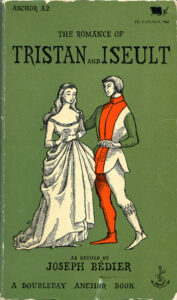(Le Roman de Tristan et Iseut)
Joseph Bédier
1900
(A knight and a lady pursue their magical love through bloodshed and sorrow.)

When tales pass through centuries of retellings, they tend to become what of audio media we would call “overproduced”: too many interpreters have slanted the story their various ways, too many embellishments and new episodes have been inserted, too many accommodations and updates have aimed at suiting the fancies of each audience. In the process the story can lose some of its grip on our imagination and our romantic sensibilities. It can be so cobbled and abused that we are left to distill the heart of it as best we can from a variety of sources. The only way such a beautiful old tale could ever be told today in anything like its original form and spirit, would be for three literary virtues to unite: a single author must be simultaneously an expert scholar, a great poet, and above all, modest. Only a scholar will know the history of the work; will be able to distinguish the wheat from the chaff in elements of theme, characterization, and plot; and will sufficiently understand an ancient teller’s perspective so as to effectively reproduce it. And only a great poet will be able to convey this perspective, and the story itself, with convincing unity and supreme skill; expectations of quality and beauty are lofty when we pick up a beloved and popular story. And finally, many a great poet and scholar will have great pride as well, in which case there will be too much of the writer and not enough of the legend in the text. Granted, we love our authors’ egos when it is them we want to see; but if the aim is to represent something of the original (or at least old) character of a romance, an author must exercise admirable self-control. We can thank Joseph Bédier for being this author in all respects for the legend of Tristan & Iseult.
 Some have called this tale in general to be the most beautiful love story we have, this amorous pair competing with Romeo & Juliet and Lancelot & Guinevere for the prime spot in humanity’s favorite kind of romance: a passionate and eternal love which is nevertheless forbidden and thus ill-fated. Tristan seeks to serve his uncle King Mark of Cornwall by defeating Ireland’s champion, and does so, but he falls in love with the woman who cures his poisoned wound: Iseult the Fair. They have no choice in the matter due to a love potion they both mistakenly drink even as he is returning with her to be the wife of his uncle. Subsequently they must deceive King Mark and, after being caught, must live as lovers separated, which brings them both to the brink of madness for love, jealousy and worry. A second Iseult steps in, she of the White Hands, but Tristan cannot love another. She succeeds in interrupting the last meeting of the lovers when Tristan, having been poisoned by a spear, calls for his beloved. Iseult of the White Hands tells him that black sails fly rather than white on the ship bound for him, the signal that Iseult the Fair is not aboard. Tristan sees no reason to stave off the poison any longer. “He said three times: ‘Iseult, my friend.’ And in saying it the fourth time, he died.” Iseult the Fair arrives beside him and dies of grief.
Some have called this tale in general to be the most beautiful love story we have, this amorous pair competing with Romeo & Juliet and Lancelot & Guinevere for the prime spot in humanity’s favorite kind of romance: a passionate and eternal love which is nevertheless forbidden and thus ill-fated. Tristan seeks to serve his uncle King Mark of Cornwall by defeating Ireland’s champion, and does so, but he falls in love with the woman who cures his poisoned wound: Iseult the Fair. They have no choice in the matter due to a love potion they both mistakenly drink even as he is returning with her to be the wife of his uncle. Subsequently they must deceive King Mark and, after being caught, must live as lovers separated, which brings them both to the brink of madness for love, jealousy and worry. A second Iseult steps in, she of the White Hands, but Tristan cannot love another. She succeeds in interrupting the last meeting of the lovers when Tristan, having been poisoned by a spear, calls for his beloved. Iseult of the White Hands tells him that black sails fly rather than white on the ship bound for him, the signal that Iseult the Fair is not aboard. Tristan sees no reason to stave off the poison any longer. “He said three times: ‘Iseult, my friend.’ And in saying it the fourth time, he died.” Iseult the Fair arrives beside him and dies of grief.
The heyday for this particular couple was in the 12th and 13th centuries, when several authors crafted popular representations of a Cornish knight who falls in love with an Irish princess as he is supposed to be escorting her to wed his own lord and adoptive father (sometimes uncle). Thomas the Rhymer, Chrétien de Troyes, and the incomplete masterwork of Gottfried von Strassburg are highlights, but none is complete (and Chrétien’s is missing). The story has been treated by several poets more recently, such as Alfred Lord Tennyson, Edwin Arlington Robinson, and Matthew Arnold. Perhaps its best known form today (apart from Hollywood) is Wagner’s opera Tristan and Isolde. However, in his seamless incorporation of many classic sources, Joseph Bédier is arguably the most faithful overall to what is likely to have been the original legend, in addition to being just a plain good storyteller. In his own words,
“In this book I have tried to avoid a mixture of the ancient and the modern. To steer clear of disparities, anachronisms, and embellishments and, through the exercise of historical understanding and critical discipline, to avoid intrusion of our modern concepts into older forms of thinking and feeling, has been my aim, my effort, and no doubt, alas, my delusion.”
Scholars debate the particulars here, but few would doubt the mastery of Bédier’s product. It is a beautiful text, with a strongly medieval feel. The book creates a wonderful impression of having been composed as an original legend by a sensitive and creative poet of the Age of Chivalry. Bédier preserves all that is especially captivating about medieval romance: mighty contests of arms, heroic ventures of rescue and vengeance, near-fatal wounds healed by arcane knowledge of marvelous herbs, a magic love potion, idyllic trysts in a lonely wood, relentless anguished passion, conflict between duty and love, faithfulness in spirit despite complex circumstances, tokens of devotion exchanged, clever ruses and disguises, the exiled lover driven to insanity, violent swings of temper between tender promises and acerbic resentment, messages sent and secrets (mostly) kept by maidservants, suspicious enemies and rogue dwarves, and, especially, final tragedy softened by the couple lying together in death.
The most readily available English edition is translated by Hilaire Belloc, a classic bilingual author and poet in his own right, so an excellent choice, though perhaps unexpected for the subject matter.
A note on the lovers’ names: Tristan (Tristram in some other versions) has been interpreted as deriving from “triste”, sad, due to the circumstances of his birth or orphanage. Indeed, the Prologue of the present version (as many others) has Blanchefleur, his mother and the sister of King Mark of Cornwall, naming her son, born just four days after learning that her husband, his father King Rivalen of Lyonesse, has died in battle: “…as by sadness you came into the world, your name shall be called Tristan; that is the child of sadness.” But there was apparently a knight Drustan of Lyonesse on which the legend was loosely based. Iseult (or Iseut, Yseult, Isolde, Isolt, and others) derives from a Welsh name Essylt meaning “beautiful to behold”—a point I am sure the reader would have safely assumed regardless.
Chapters
Part the First
- The Childhood of Tristan
- The Morholt out of Ireland
- The Quest of the Lady with the Hair of Gold
- The Philtre
- The Tall Pine-Tree
- The Discovery
- The Chantry Leap
Part the Second
- The Wood of Morois
- Ogrin the Hermit
- The Ford
- The Ordeal by Iron
Part the Third
- The Little Fairy Bell
- Iseult of the White Hands
- The Madness of Tristan
- The Death of Tristan
Tidbits of Significance
(translated from the French by Hilaire Belloc and Paul Rosenfeld):
My Lords
If you would hear a high tale of love and of death,
here is that of Tristan and Queen Iseult;
how to their full joy, but to their sorrow also,they loved each other, and how at last
they died of that love together upon one day;
she by him and he by her.
-Preface
…hope in the heart of man lives on lean pasture.
-“The Morholt out of Ireland”
she had found not wine — but Passion and Joy most sharp, and Anguish without end, and Death.
-of the maid who brought the love potion to Iseult, “The Philtre”
It seemed to Tristan as though an ardent briar, sharp-thorned but with flower most sweet smelling drave roots into his blood and laced the lovely body of Iseult all round about it and bound it to his own and to his every thought and desire.
-“The Philtre”
But Iseult loved him, though she would have hated. Had he not basely disdained her? She could not hate, for a tenderness more sharp than hatred tore her.
-“The Philtre”
The lovers held each other; life and desire trembled through their youth, and Tristan said, “Well then, come Death.”
-“The Philtre”
For men see this and that outward thing, but God alone the heart, and in the heart alone is Crime and the sole final judge is God. Therefore did He lay down the law that a man accused might uphold his cause by battle, and God himself fights for the innocent in such a combat.
-“The Dwarf Frocin”
Iseult rose up; they held each other’s hands. They passed into the high grass and the underwood: the trees hid them with their branches. They disappeared beyond the curtain of the leaves.
-“The Wood of Morois”
“Oh friend,” she said, “fold your arms round me close and strain me so that our hearts may break and our souls go free at last. Take me to that happy place of which you told me long ago. The fields whence none return, but where great singers sing their songs for ever. Take me now.”
-“Tristan Mad”
“…tell her that my heart salutes her; tell her that she alone can bring me comfort; tell her that if she does not come I shall die. Tell her to remember our past time, and our great sorrows, and all the joy there was in our loyal and tender love. And tell her to remember that draught we drank together on the high seas. For we drank our death together. Tell her to remember the oath I swore to serve a single love, for I have kept that oath.”
-Tristan to his friend Kaherdin, “The Death of Tristan”
Now a woman’s wrath is a fearful thing, and all men fear it, for according to her love, so will her vengeance be; and their love and their hate come quickly, but their hate lives longer than their love; and they will make play with love, but not with hate.
-on the treachery of Iseult of the White Hands, “The Death of Tristan”
The good singers of old time,
Béroul and Thomas of Built, Gilbert and Gottfried
told this tale for lovers and none other,
and, by my pen, they beg you for your prayers.
They greet those who are cast down,
and those in heart, those troubled and those
filled with desire, those who are overjoyed
and those disconsolate, all lovers.
May all herein find strength against
inconstancy, against unfairness
and despite and loss and
pain and all the bitterness
of loving.
-Epilogue
Tips
READ THIS WHEN…
…you are being drawn into the tumultuous abyss of love’s enchantments;
or,
…you seek a faithful modern prose rendition of a classic of the Age of Chivalry.
IF YOU LIKED THIS, YOU’D ALSO LIKE:
(for the clandestine lover:)
- Geoffrey Chaucer, Troilus and Criseyde (c.1386).
- William Shakespeare, Romeo and Juliet (c.1595).
- Edith Wharton, Ethan Frome (1911).
- Boris Pasternak, Doctor Zhivago (1956).
(for the defender of courtly romance in Arthurian legend:)
- Marie de France, Lais (c.1170).
- Chrétien de Troyes, The Knight of the Cart (late 12th century).
- Gottfried von Strassburg, Tristan (c.1210).
- Edward Arlington Robinson, Lancelot (1920).
Find It!
(…in English, translated by Hilaire Belloc:)
Hardcover: I have published an illustrated hardcover edition complete with all of the contents of this entry: the first of Lahti Annotated Classics.
Paperback: An attractive edition, Vintage Classics.











